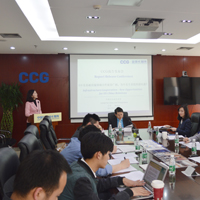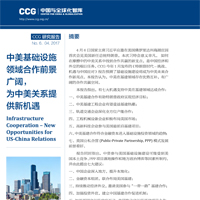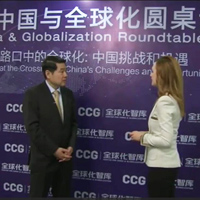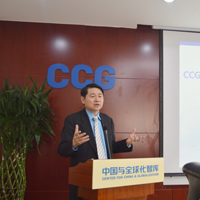-

【人民网】CCG报告:基础设施合作为中美关系提供新机遇
人民网北京4月6日电 ,国家主席习近平在美国佛罗里达州首次会见美国新任总统特朗普。本次“习特会”意义非凡,如何在中美关系中找到合作共赢的新支点,是中国经济和外交的艰巨任务。 4月5日“习特会”前夕,中国与全球化智库(CCG)在北京发布报告《中美基础设施领域合作前景广阔,为中美关系提供新机遇》。该报告回顾了特朗普基建计划的背景,分析了中美在基建领域达成合作的机遇和存在的挑战。报告认为,中美在基建领域存在较大优势互补,有广阔合作共赢空间,在特朗普治下的中美关系中发挥积极意义,并由此从不同层面提出了加强中美基建合作的具体建议。 在两国元首会晤前夕,美国国务卿蒂乐森在亚洲之行的中国站表示,中美关系的基调只能是合作与友谊,并多次强调了“不冲突、不对抗、互相尊重和双赢”原则,蒂乐森的态度传达出特朗普政府对中美合作的积极动能。《金融时报》副主编马丁·沃尔夫在“中美:注定合作的超级大国”文中提出“习特会”的关键是找到合作的基础,“特朗普希望在美国掀起基建热潮,而中国是目前世界上基建快速建设的最强典范。将中国的基建能力与特朗普的目标结合起来一定可行。”这与CCG今年1月发布的《特朗普时代的挑战、机遇与中国应对》报告预测的基础设施建设将成为中美未来合作新亮点的观点不谋而合。 中国与全球化智库(CCG)主任王辉耀表示,“习特会”是少见的美国新总统在就任一百天内就安排两国元首进行双边而不是多边场合下的会晤,在中美关系史上别具意义。以反对全球化和自由贸易立场胜选的特朗普走马上任后立即推出了一系列饱受争议的强硬政策,向支持者表明其实现竞选承诺的决心。对于中国而言,2017年是纵深推进全面深化改革和“十三五”规划的关键之年,也是中共召开十九大之年,面对国际环境新变化和国内发展新要求,中国将继续推动更深层次更高水平的对外开放,建设开放型经济新体制。如何在摩擦中的中美关系中找到合作共赢的新支点,是中国经济和外交的艰巨任务。 CCG报告指出,在新总统的复兴美国蓝图中,其中一个关键就是通过基础设施投资提振美国经济。其百日新政宣言里,特朗普提出了未来十年内基础设施投资规模达到一万亿美元的数字。在就职后的首次国会演讲中,特朗普表示,“为了开启新的国家重振计划,我将要求国会批准能带来一万亿美元基础设施投资的立法措施。” 中国在基础设施建设上拥有资本、技术和经验的相对优势, 根据中国统计局,我国在2016年前10个月的基础设施投资已达到94928亿元(约1.4万亿美元),也就是说,中国在不到一年的时间里,已经完成了特朗普十年的基建投资计划。与此同时,中国对美国投资热情不减,2016年中国对美国投资总量达到456亿美元,创下历史新高。报告认为,中美在基建领域存在较大的优势互补,有广阔的合作共赢空间。 报告分析了中美在基建领域达成合作的七个机遇:中美基建企业有望受益基建热潮;轨道交通企业深化全方位产能合作;工程机械设备企业积极争取深化合作;高新科技企业参与美国最前沿基建项目;中美基建合作符合金融资本进入基础设施投资领域的趋势;美国公私合营(Public-Private Partnership, PPP)模式发展前景看好;中美基建合作有助特朗普政府实现经济目标。 CCG报告同时指出,中资参与美国基础设施建设可能受到美国本土竞争、PPP项目落地操作和地方政治博弈等因素所制约,并由此提出七项建议:中国企业深入地方,提升本地化;金融资本组团,联合参与美国基建;持续推动经济外交,邀请美国参与“一带一路”基建合作;加强投资外宣,建立中国基建合作促进机制;加强两国省州级政府互动,共同推动省州级基建项目合作;发挥中美智库在公共外交作用,为稳定中美关系建言献策;进一步拓宽“二轨”通道,加强有利中国投资的国际公共关系。 CCG报告总结,对急于向选民证明而受到挫败的特朗普来说,目前最紧迫的是找到让选民看得见、摸得着的政绩。他的宏伟的万亿基建方案在短期内要获得国会支持绝非易事。基建领域投资本身在规模、地域、行业结构、联邦和地方存在很大的博弈空间,白宫和两院的分歧增加了博弈风险。在此次 “习特会”中,一个务实的特朗普更有可能抓住中美在基建领域合作共赢的机遇。(常红 陈彦彦)文章选自人民网,2017年4月6日
2017年4月11日 -

【光明网】中国与全球化智库:基建领域合作有望推动中美关系取得更大发展
光明网讯(记者 张胜)作为两个具有全球影响的大国,中美关系的重要性不言而喻。维护好、发展好中美关系,不仅符合两国人民利益,也是国际社会的普遍期待。如何寻找中美两国合作共赢的新支点?中国与全球化智库日前在京发布《中美基础设施领域合作前景广阔 为中美关系提供新机遇》研究报告。报告认为,中美两国在基建领域各具优势,可以通过互补,开创更为广阔的合作共赢空间。 报告分析认为,中美基建合作有助特朗普政府实现经济目标;中美基建工程企业有望受益基建热潮;轨道交通企业深化全方位产能合作;工程机械设备企业积极布局美国市场;中美基建合作符合金融资本进入基础设施投资领域的趋势等原因将有力支持中美两国在基础设施建设领域达成合作。 针对中资参与美国基础设施建设可能受到的美国本土竞争、PPP 项目落地操作等潜在制约因素,报告提出:中国企业在走出去的过程中应深入地方,在美国开拓基建市场过程中,要力求适应当地市场和法规要求,逐步实现物资采购和劳动力使用的本土化,在选择美国合作商时可考虑雇佣一定比例的妇女和少数族裔工人,争取地方政府支持。报告认为,中美基建合作对未来重启双边投资协定(BIT) 谈判具有一定促进作用,为此,可持续推动经济外交,邀请美国参与“一带一路”基建合作;同时,加强我国投资的外宣工作,探索建立并逐步完善我国基建合作促进机制。报告认为,美国州政府可以成为中美关系的“稳定器”,建议每年在中美两地轮流举办中美省州长论坛,通过地方政府的紧密联系来推动省州级基建项目的合作开展。文章选自光明网,2017年4月6日
2017年4月11日 -
Wang Huiyao: How a Xi-Trump summit could yield progress
Wang Huiyao: China should send signal on North Korea and support Trump’s $1tn infrastructure planThe first meeting between Xi Jinping, China’s president, and Donald Trump, his US counterpart, has generated intense interest across the Pacific. Mr Trump’s invitation to Mr Xi came earlier than expected but the US president has already toned down his rhetoric against the country that he believes has caused huge trade deficits and job losses for the US.The US president wrote in a tweet that Thursday’s meeting in Florida “will be a very difficult one”. While there are bumps in the road, Mr Xi can still score co-operation rather than confrontation with Mr Trump if he orients the meeting towards the 10 following areas of co-operation:● Expanding channels of dialogue and communication between the two governments. An early invitation extended to Mr Trump’s economic team to visit China would help, as would more exchanges between academic and business leaders in the track-two settings.● Separating the economic track from the strategic one. China’s outbound investment in the US surpassed the inbound foreign direct investment (FDI) from the US in 2015 and in 2016. Highlighting the effects of Chinese investments on manufacturing jobs creation — estimated to be more than 100,000 jobs created in recent years — aligns well with Mr Trump’s promises to his Rust Belt supporters.● Improving conditions for American companies operating in China. US multinational corporations in China have traditionally played the role of “stabiliser” in US-China relations, with their pro-China voices on Capitol Hill. It is time for Beijing to tap into the support of its natural allies by helping them succeed in China.● Enlisting US support for regional economic integration in Asia-Pacific. Mr Trump withdrew the US from the Trans-Pacific Partnerships (TPP) agreement, disappointing the desire of the world’s most economically dynamic region for multilateral trade architecture. Although Mr Trump is unlikely to switch from his signature anti-free trade stance, he can still be informed of the potential benefits that the Free Trade Area of the Asia Pacific (FTAAP) could deliver.● Highlighting the positive effects of Sino-American collaboration on tourism and education on the US economy. More than a third of international students in American universities are from China. Close to 5m Chinese tourists — who tend to spend freely — visit US cities each year. But there is a concern that Mr Trump’s trade war rhetoric is going to damp Chinese tourists’ enthusiasm for the US.● Pledging support for Mr Trump’s $1tn infrastructure plan. Fiscal measures alone are unlikely to mobilise the tremendous capital needed to rebuild the US’s dilapidated roads and bridges. Mr Trump will have to count on public-private partnership deals and foreign investors. Boasting a clear competitive edge, China is poised to participate in American infrastructure with its capital, technology and experience. Beijing can even invite the US to join the Asian Infrastructure Investment Bank (AIIB).● Strengthening ties with the US’s state and local governments. This can be done through exchange platforms such as the China-US Governors Forum. The Chinese business community is encouraged to embed their US operations in the hosting localities by building relations with non-profits such as trade unions, industry associations, charity organisations and so on.● Mitigating geopolitical tensions in east Asia. Demonstrating resolve to work with the US in curtailing North Korea’s nuclear ambitions not only sends a signal to Pyongyang, but also helps ease the security anxiety of South Korea and Japan, two US allies that have been fearful of Mr Trump’s reduced commitment to Asian alliances and have consequently resorted to a further military build-up.● Stepping up co-operation with the US on global governance. For many years the White House has accused China of shirking international responsibilities. Now, Mr Xi has formally committed China to playing an increasing role in global governance. Although Mr Trump has said the US will pull out of the Paris climate change accord, America is unlikely to ease off tackling thorny international issues with other major powers.● Promoting track-two interactions between societal actors in both countries. Think- tanks, in particular, are in a unique position to foster positive understandings on the political and socio-economic situations of the two sides. The “revolving door” practice helps integrate diverse perspectives from the academic, commercial and policymaking communities. Chinese think-tanks, especially those without government ties, are expected to step up to provide better policy consulting services as well as aid in the country’s diplomacy.With the Trump-Xi meeting only a day away, all eyes are on the irritants of the bilateral relations. However, while the road to Mar-a-Lago appears bumpy, there are still grounds for optimism. The buzz over “Chimerica” may have dissipated but the relationships between the world’s two largest economies are simply too multi-faceted, interdependent, and complex for Mr Trump to undo.From Financial Times, 2017-4-5About AuthorWang Huiyao, founder and president of Center for China and Globalization (CCG),Beijing.
2017年4月11日 -
王辉耀:“习特会”看点:如何取得积极进展 | FT中文网
王辉耀:尽管前路坎坷,但如果习特峰会能围绕10个合作领域展开,中美就可能避免冲突和对抗,并在未来达成合作。 中国国家主席习近平与美国总统唐纳德·特朗普的首次会晤已然在太平洋两岸引起了广泛关注。特朗普对习近平发出会见的邀请早于预期,而此前,他已经缓和了把美国巨额贸易赤字和失业归咎于中国的言论。 特朗普在推特中写道,两国元首周四在佛罗里达的会见“将非常困难”。然而,尽管前路坎坷,如果习特峰会能围绕以下10个合作领域展开,冲突和对抗可能避免,并在未来达成合作。 一、扩大两国对话沟通渠道。中美关系在2017年上半年尚处在各自调整和逐步适应的过程。当前,两国元首会晤已启动,中国要继续发挥各方力量,加强与美国新政府各层次的联系,尽早邀请特朗普经济团队访问中国,促进学术界和商界领袖之间展开更多“二轨”对话。 二、优先国家战略中的经济外交。中美是推动世界经济的两大引擎,中国对美国的对外直接投资(FDI)在2015年和2016年都超过了美国对中国的FDI,而且,福耀集团等中国企业为美国带来的就业机会表明,中国投资对美国制造业就业的提振有非常积极的影响——预估近些年将带来超过10万个就业岗位,这与特朗普对其“铁锈地带”支持者的承诺非常契合。 三、改善美国公司在中国的经营环境。拥有强大游说能力的美国跨国公司传统上发挥了中美经贸关系“稳定器”的作用。今天,美中关系全国委员会和美国商会等组织仍然起着促进中美经贸发展的积极作用。中国应进一步完善政策,鼓励和促进美国跨国公司在中国的投资与经营,助力其“天然盟友”美国企业在华取得成功。 四、争取美国对亚太区域经济一体化的支持。特朗普宣布美国退出“跨太平洋伙伴关系”(TPP)协议,使致力于发展多边贸易的世界上最具经济活力的亚太地区失望。尽管特朗普不太可能转变其反对自由贸易的立场,但仍可促其了解亚太自由贸易区(FTAAP)将带来的潜在益处,以发挥中美合作的正能量。 五、强化中美旅游和留学等人文交流与合作的积极影响。来自中国的留学生占在美留学生的三分之一,每年近500万中国游客赴美旅游和消费。然而,特朗普对贸易战争的言论或会削弱中国人赴美的积极性,旅游和教育则极大地扩展了中美合作的民意基础,将在当前以及今后更长的时间里成为中美双边关系的重要纽带。 六、支持特朗普1万亿美元的基础设施计划。单靠财政措施不可能调动重建美国破旧道路和桥梁所需的巨额资金,特朗普将不得不依靠公私合作协议(PPP)和外国的投资者。而中国过去几十年来发展了强大的基建能力,在资金、技术、项目管理经验方面具有明显竞争优势,与美国重振基础设施的合作将会甚有裨益。中国还可以邀请美国加入亚洲基础设施投资银行(AIIB),双方在“一带一路”基建领域的合作潜力巨大。 七、加强与美国各州政府和地方政府的合作。联邦制的美国很多权力分布在各个州,中国企业在美国很多州都有投资,并成为美国州政府的座上宾,建议每年在中美两地轮流举办美国州长和中国省市自治区省级领导参加的中美省州长论坛。同时,鼓励中国企业通过建立与非营利组织的良好关系,如工会、行业协会和慈善组织等,加强与美国各地相关组织的融合与合作。 八、缓解东亚的地缘政治紧张局势。在遏制朝鲜的核武器野心方面与美国合作决心的表态,不仅将向平壤明确发出信号,也有助于缓解韩国和日本这两个美国盟友的安全焦虑。当前,韩日都已因担心特朗普战略收缩、减少对其亚洲盟国的承诺而进一步加强了军事集结。同时,中国应继续加强改善中日韩关系。 九、增进中美全球治理合作。从前,美国常指责中国推卸国际责任,而中国现已向全世界承诺中国将承担国际责任,在全球治理中发挥更大作用。虽然特朗普曾表示美国将撤出巴黎气候变化协议,但美国不可能完全放手与其他大国合作解决一些复杂的国际问题。中美可在气候变化等多个领域充分展开协作。 十、推动两国“二轨外交”的开展。智库在促进两国相互了解各自政治和社会经济情况、消除分歧方面发挥着独特的作用。“旋转门”机制的实践有助于充分整合来自学界、商界和政策制定者的多元观点。本届中国政府亦十分重视中国新型智库建设,特别是相对独立的社会智库,能够更客观、专业地提供政策咨询及服务于中国外交。 “习特会”在即,全世界都聚焦于中美的双边关系中的摩擦。然而,尽管通往特朗普位于佛罗里达州海湖庄园的道路看起来并不平坦,我们仍然有理由对中美关系保持乐观。“中美共同体”(Chimerica)这种提法已经消散,但中美作为世界上最大的两个经济体,两国之间高度多元、复杂、相互依赖的关系是特朗普个人无法解除的。作者简介王辉耀,中国与全球化智库(CCG)创始人兼理事长。文章选自FT中文网,2017年4月6日
2017年4月11日 -

【CGTN】Experts: China, US trade relations set to normalize after Xi-Trump meeting
[VIDEO WATCHING]What was billed as a showdown between the leaders of the United States and China over trade and the DPRK failed to truly materialize. US President Donald Trump previously predicted a "very difficult" meeting with Chinese President Xi Jinping. But, after their first face-to-face meeting at the Mar-a-Lago resort, he trumpeted that they had developed an "outstanding" relationship.It was an opportunity for the leaders of the world’s two largest economies to get to know each other better and build initial trust, although little was produced in the way of tangible outcomes.Time was too short it seems to announce any major trade or investment deal. Experts are now trying to make sense of the Xi-Trump summit, and ponder the next steps in the relationship between the two superpowers.At the forum of a leading Chinese global think tank in Beijing on Sunday, participants were optimistic. Wang Huiyao, the President of the Center for China and Globalization, said that infrastructure and energy cooperation are two of the concrete things that President Xi mentioned, which send a very good signal around the world.During the talks, Trump also pressed Chinese President Xi Jinping to do more to help reduce the US trade deficit with China, which reached 347 billion US dollars last year. However, Wang Yiwei, professor at the School of International Studies in Renmin University of China, interpreted it as a result of global division for labor, not a political intention.The United States mainly imports consumer electronics, clothing and machinery from China. A lot of the imports are from US manufacturers that send raw materials to China for low-cost assembly.Trump had pledged to label China a currency manipulator on the first day of his administration, but has refrained to do so so far. Yet, he has been loud and clear on accusing China of stealing US manufacturing jobs.The two leaders agreed to a "100-day plan" to discuss trade, aimed at boosting US exports and reducing China’s trade surplus with the US, but few details have emerged so far. (By Wang Xinxin)From CGTN , April 2017
2017年4月11日 -
施一公:时不我待 舍我其谁
专家简介施一公,中国与全球化智库(CCG)学术专家委员会专家,清华大学副校长。3月4日,习近平总书记参加全国政协十二届五次会议民进、农工、九三学社委员联组会议并发表重要讲话,在全党全社会产生热烈反响。《人民日报海外版》特邀请部分党外知识分子畅谈体会和认识,就如何进一步凝聚思想共识、发挥自身优势、致力伟大事业表达诉求、发表见解。——编者 今年是我回国工作的第十个年头。10年前,我的实验室刚刚启动,首批学生还懵懵懂懂。2007年3月我的清华实验室开始了第一个科学实验。而今,我们于2015年发表的剪接体结构已经登上了国际经典生物化学教科书的封面,我在清华培养的博士生已经在中外研究机构开始独立领导实验室。 2006年当我决定放弃美国普林斯顿大学的教授职位全职回国的时候,有很多人疑惑不解,认为我疯了;可是今日回头看,我想再没有人会怀疑这个决定的正确性。这10年,我亲身见证、经历、更重要的是亲身参与了中国的高速发展,深切感受到民族复兴的中国梦是切切实实正在发生的进行时。 然而这10年,当中国国内稳定发展时,世界大势却发生了巨大变迁,特别是近几年的变化可用“目不暇接”来形容。在瞬息万变的国际环境中,“打铁还需自身硬”,科技强国、人才兴国。运用科技为中国的社会经济健康发展、为人民的幸福安康保驾护航是科技工作者的使命。 “我国广大知识分子要以时不我待的紧迫感、舍我其谁的责任感,主动担当,积极作为”,习近平总书记3月4日看望政协委员时的这番讲话既是对广大知识分子的激励和鞭策,也道出了我们的心声。 过去10年,中国的基础研究和应用研究都取得了长足进步。可作为工作在国内一线的科学家,我却反而有了更多的紧迫感,原因很简单:我国已经一跃成为世界上第二大经济体。之前我们的心态多为追赶,前方的路或多或少有迹可循、有经验教训可以借鉴;但是现在我们要开始调整心态,也许在不久的将来,在若干领域要思考如何“引领”的问题。我们既面临着前所未有的机遇,也必须要面对错综复杂的挑战。所以,我对总书记讲话中连提三个创新心有戚戚:“不断强化创新意识,不断提升创新能力,不断攀登创新高峰。”秉持创新的精神锻造自身实力,运用创新的思维应对不可预测的挑战。中国的科技工作者,作为创新的主力军,责任重大! 结合自身实践,我以为,作为一线的科技人员,创新体现在对于本领域科研工作敢为天下先的追求,发挥才智,探索未知,为人类文明书写新篇章,为经济发展提供新引擎。而另一方面,2008—2015年间,受学校信任我负责清华大学生命医学建设,在国家有关部门和学校的大力支持下,我们在科研教学几个方面同时进行改革尝试,今天清华大学已经成为备受国际瞩目的生命科学研究中心和人才培养基地之一。回顾这期间的经验教训,我充分认识到作为一个机构的管理者,创新体现在对新机制体制的不断探索,以及在实践中解决问题的智慧、不忘初心推进改革的勇气和韧性。 中国的发展和强大需要我们每一个人的努力。6年前,我在“千人计划专家联谊会”成立大会上曾经呼吁我们每一位专家要“树正气,去私心,敢担当,有作为”,要把个人奋斗与国家的发展紧密联系起来,在中华民族的伟大复兴中升华人生价值。这是我过去、现在以及未来会一直努力践行的准则。 总书记讲话中体现出来的对知识分子的尊重、信任与倚重更是一缕春风,让我们为了国强民富、青山常在、绿水长流的美好明天而心无旁骛地努力,轻装前行。惟行胜于言,直挂云帆济沧海。文章选自《人民日报海外版》,2017年3月29日
2017年4月7日 -

【China Daily】China could help US rebuild aging infrastructure, thinktank says
China and the United States will both benefit if they work together on infrastructure construction, a top think tank reported on April 5.The report is titled Infrastructure Cooperation: New Opportunities for US-China Relations and published by Beijing-based Center for China and Globalization(CCG). It explains how several projects in which Chinese companies have entered the US market are helping the US government meet goals set by President Donald Trump during his campaign.It said that as Trump plans to develop transportation and energy facilities, build a next-generation internet network and improve veterans hospitals, the US needs Chinese businesses to put these big-ticket projects into place.Chinese firms, such as China State Construction Engineering Corp and China Communications Construction Co, have already been helping the US upgrade some projects, including the New York City subway in Manhattan, the subway station near Yankee Stadium in the Bronx, a coliseum in South Carolina and a massive entertainment hotel and casino in New Jersey.“Chinese construction and railway vehicle companies have made impressive inroads into the US market with their quality products, advanced management expertise and comprehensive after-sales services. They are making contributions to the US economy by improving the country’s infrastructure,” said Wang Huiyao, the think tank’s president.The US is coming to grips with its aging bridges, rail lines, tunnels and roads, ranking 19th in infrastructure development, according to the Global Competitiveness Report by the World Economic Forum.The US consulting firm Rhodium Group said that from 2013 to 2030, the US will have to spend $8.2 trillion upgrading its infrastructure.The report predicted Trump’s plans will further motivate Chinese heavy equipment manufacturing conglomerates to expand into the US market.Chinese companies can earn decent returns from the US market, and as a result could open more subsidiaries in the country to directly invest in infrastructure projects in the US. This would not only create growth in the US, but also enable Chinese companies to expand their presence in more developed markets.CRRC Sifang America, an arm of railway equipment manufacturer China Railway Rolling Stock Corp, broke ground in Chicago on a $100 million plant to build rail cars for the city’s transit authority last month.CRRC also started to build a $95 million plant in Massachusetts to build rail cars for Boston’s transit authority in 2015. Completion of the plant is scheduled this year. (By Zhong Nan and Ren Xiaojin)From China Daily,2017-4-6
2017年4月7日